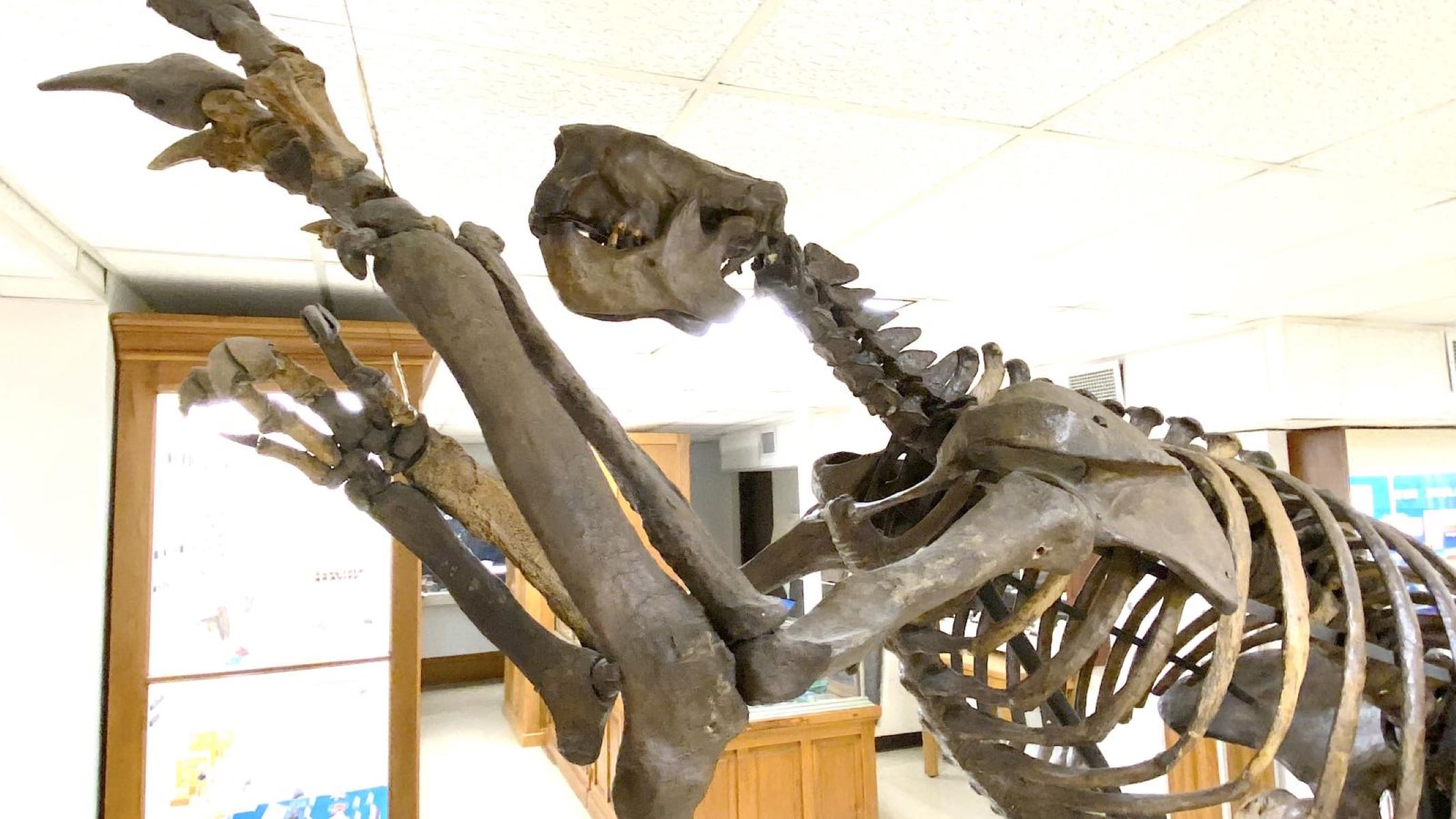
Ever wondered about the Megalonyx jeffersonii skull? This ancient creature, also known as Jefferson's ground sloth, roamed North America during the Ice Age. Named after Thomas Jefferson, who had a keen interest in paleontology, this giant sloth's skull holds many secrets about its life and times. Imagine a skull so large it dwarfs most modern animals, with teeth designed for a herbivorous diet. The Megalonyx jeffersonii wasn't just any sloth; it was a massive, ground-dwelling giant that could weigh up to 2,200 pounds! Intrigued? Let's dive into 35 fascinating facts about this prehistoric marvel.
Key Takeaways:
- Megalonyx Jeffersonii, or Jefferson's ground sloth, had a robust skull designed for chewing tough vegetation, a keen sense of smell, and a wide field of vision for survival in its Pleistocene environment.
- The study of Megalonyx Jeffersonii's fossils has contributed to our understanding of prehistoric life, its cultural impact, and ongoing research continues to uncover new insights about this fascinating giant sloth.
What is Megalonyx Jeffersonii?
Megalonyx jeffersonii, also known as Jefferson's ground sloth, roamed North America during the Pleistocene epoch. This giant sloth species was named after Thomas Jefferson, who studied its fossils. Let's dive into some fascinating facts about its skull.
Skull Structure
The skull of Megalonyx jeffersonii offers a glimpse into the life of this prehistoric giant. Here are some intriguing details about its structure:
- The skull was robust and heavy, designed to support powerful jaw muscles.
- It had a broad, flat snout, which helped it strip leaves and bark from trees.
- The eye sockets were positioned on the sides of the head, providing a wide field of vision.
- Its nasal cavity was large, suggesting a keen sense of smell.
- The skull had a pronounced sagittal crest, indicating strong jaw muscles for chewing tough vegetation.
Teeth and Diet
The teeth of Megalonyx jeffersonii reveal much about its diet and feeding habits. Here are some key points:
- It had peg-like teeth, ideal for grinding plant material.
- Unlike modern sloths, it lacked canines, reflecting its herbivorous diet.
- The molars were flat and ridged, perfect for breaking down fibrous plants.
- Tooth wear patterns suggest it fed on a variety of vegetation, including leaves, twigs, and bark.
- The teeth grew continuously, compensating for the constant wear from chewing tough plant matter.
Evolutionary Significance
Megalonyx jeffersonii holds an important place in the evolutionary history of sloths. Here are some notable facts:
- It belonged to the family Megalonychidae, which includes both extinct and extant sloths.
- The species evolved from smaller, tree-dwelling ancestors.
- Its large size was an adaptation to a ground-dwelling lifestyle.
- Fossil evidence shows it lived alongside other megafauna like mammoths and saber-toothed cats.
- The species went extinct around 11,000 years ago, likely due to climate change and human activity.
Discovery and Research
The discovery and study of Megalonyx jeffersonii have provided valuable insights into prehistoric life. Here are some highlights:
- Thomas Jefferson first described the species in 1797, based on fossil bones found in a cave in West Virginia.
- The name "Megalonyx" means "great claw," referring to its large, curved claws.
- Jefferson's interest in the fossils helped spark early American paleontology.
- Numerous fossils have been found across North America, from Alaska to Florida.
- Modern techniques like CT scanning have allowed scientists to study the skull's internal structure in detail.
Adaptations and Behavior
The skull of Megalonyx jeffersonii reveals adaptations that helped it survive in its environment. Here are some key points:
- The large nasal cavity suggests it had a keen sense of smell, useful for finding food.
- Its wide field of vision helped it detect predators and navigate dense forests.
- The strong jaw muscles allowed it to process tough plant material efficiently.
- The skull's robust structure protected its brain from injury.
- Fossil evidence suggests it was a solitary animal, relying on its size and strength for defense.
Cultural Impact
Megalonyx jeffersonii has left a lasting impact on science and culture. Here are some interesting facts:
- Thomas Jefferson's study of the fossils contributed to his reputation as a scientist.
- The species is often featured in museums and educational programs about prehistoric life.
- It has appeared in various books and documentaries about the Ice Age.
- The discovery of its fossils has helped scientists understand the Pleistocene ecosystem.
- The species is a symbol of North America's rich prehistoric heritage.
Modern Research and Discoveries
Ongoing research continues to uncover new information about Megalonyx jeffersonii. Here are some recent findings:
- DNA analysis has provided insights into its evolutionary relationships with other sloths.
- Isotope analysis of its teeth has revealed details about its diet and migration patterns.
- New fossil discoveries have expanded our understanding of its geographic range.
- Studies of its bone structure have shed light on its growth and development.
- Research on its extinction has provided clues about the impacts of climate change and human activity on megafauna.
The Final Word on Megalonyx Jeffersonii Skull
Megalonyx jeffersonii, a fascinating creature from the Ice Age, offers a glimpse into prehistoric life. Its skull, with unique features, tells a story of adaptation and survival. This giant ground sloth roamed North America, leaving behind clues about its diet, behavior, and environment. Understanding these facts helps us appreciate the diversity of ancient wildlife and the evolutionary processes that shaped them.
From its powerful jaws to its distinctive teeth, the Megalonyx jeffersonii skull reveals much about this extinct species. Researchers continue to study these remains, uncovering new insights that deepen our knowledge of the past. As we piece together the puzzle of its existence, we gain a greater appreciation for the natural world and its history.
So, next time you think about prehistoric creatures, remember the Megalonyx jeffersonii and its remarkable skull. It’s a testament to the wonders of evolution and the mysteries still waiting to be discovered.
Frequently Asked Questions
Was this page helpful?
Our commitment to delivering trustworthy and engaging content is at the heart of what we do. Each fact on our site is contributed by real users like you, bringing a wealth of diverse insights and information. To ensure the highest standards of accuracy and reliability, our dedicated editors meticulously review each submission. This process guarantees that the facts we share are not only fascinating but also credible. Trust in our commitment to quality and authenticity as you explore and learn with us.


